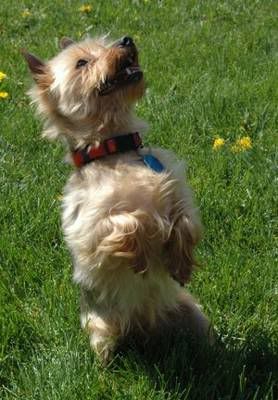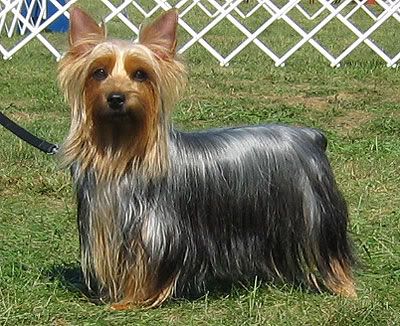Post by charmingnancy on Apr 21, 2009 15:49:54 GMT -5
Silky Terrier
Group: 5- Toys
Origin: Australia
Purpose: Companion, small-vermin hunting dog

Description:
The Silky is a lightly built, moderately low-set, toy dog of pronounced terrier character and spirited action.
Appearance- Breed Standards:
Coat and Color: Coat flat in texture, fine, glossy, silky; on matured specimens the desired length of coat from behind the ears to the set on of the tail is from 5 - 6 inches (13 - 15cm). On the top of the head the hair is so profuse as to form a topknot, but long hair on the face and ears is objectionable. Legs from knee and hock joints to feet should be free from long hair. The hair is parted on the head and down over the back to the root of the tail.
Colour blue and tan. The blue may be silver blue, pigeon blue or slate blue, the tan deep and rich. The blue extends from the base of the skull to the tip of the tail, down the forelegs to the pasterns, and down the thighs to the hocks. On the tail the blue should be very dark. Tan appears on the muzzle and cheeks, around the base of the ears, below the pasterns and hocks, and around the vent. There is a tan spot over each eye. The topknot should be silver or fawn.
Head: The head is strong, wedge-shaped, and moderately long. The skull is a trifle longer than the muzzle, in proportion about three-fifths for the skull, two-fifths for the muzzle. Skull flat, and not too wide between the ears. Stop shallow. The nose is black. Teeth strong and well-aligned. Scissors bite. Eyes dark in colour, and piercingly keen in expression. Ears small, V-shaped and pricked. They are set high and carried erect without any tendency to flare obliquely off the skull.
Neck: The neck fits gracefully into sloping shoulders. It is medium long, fine and to some degree crested along its topline.
Forequarters: Well laid-back shoulders, together with good angulation at the upper arm, set the forelegs nicely under the body. Forelegs are strong, straight, and rather fine-boned.
Body: Low-set, about one-fifth longer than the dog's height at the withers. The backline is straight, with a just perceptible rounding over the loins. Brisket medium wide, and deep enough to extend down to the elbows.
Hindquarters: Thighs well muscled and strong, but no so developed as to appear heavy. Legs moderately angled at stifles and hocks, with the hocks low and equidistant from the hock joints to the ground. Feet small, cat-like, round, compact. Pads are thick and springy while the nails are strong and dark coloured. The feet point straight ahead, with no turning in or out. Dewclaws, if any, are removed.
Tail: The tail is set high and carried erect or semi-erect but not over-gay. It is docked and well coated but devoid of plume.
Gait: Should be free, light footed, lively, and straight forward. Hindquarters should have strong propelling power.
Faults: Shyness or excessive nervousness. A bite markedly undershot or overshot is a serious fault. Light eyes are a fault. A too-short body is a fault. White or flesh-coloured nails are a fault. Toeing in or out on the move is to be faulted.
Size:
Weight ranges from 8-10 lb. (4-5 kg.). Shoulder height from 9-10 inches (23-25 cm). Pronounced diminutiveness (such as a height of less that 8 inches [20 cm]) is not desired; it accentuates the quality of toyishness as opposed to the breed’s definite terrier character.

Temperament:
The keen, alert air of the terrier is characteristic, with shyness or excessive nervousness to be faulted. The manner is quick, friendly, responsive.
Health:
There are no major health concerns for this breed. Minor concerns include intervertebral disc disease, elbow dysplasia, patellar luxation, Legg – Perthes. Occasionally seen health problems are diabetes, epilepsy, tracheal collapse.
Average Lifespan:
11 – 14 years.

History:
In the late 1800s, Yorkshire terriers first arrived in Australia from England. The Yorkies, with their steel-blue and tan coat, were bred with terriers already located in Australia as an urban pet. The crossbreeding was an attempt to improve the native terrier’s blue and tan coat while maintaining its hearty form. The resulting dog’s size and coat length was a perfect transition between its two parent breeds. Since both the Yorkshire terrier and the Australian terrier were fairly new breeds, this interbreeding produced some classification issues. Some members of the resulting breed were shown as Yorkshire terriers and others were called Australian terriers. A few were listed under the new name of “silky terrier,” since it was felt that they were the start of a new breed altogether.
The breed was developed in two parts of Australia, and the appropriate weight of the breed was greatly disputed. In 1926, a compromise was accepted, and a standard was written to include the silkies from both areas. Initially known as the Sydney silky terrier, its name was changed to Australian silky terrier in 1955.
On March 25, 1955, the first official meeting of the Sydney Silky Terrier Club of America was held. In July, the club changed its name to the Silky Terrier Club of America shortly before the AKC recognized the breed. The silky is not a rare breed, but it has not gained much popularity among dog fanciers.
Sources:
Silky Terrier Club of Canada (Breed Standards)
CKC- Breed Standards (Size)
5 Star Dog
Pictures:
Photobucket
Group: 5- Toys
Origin: Australia
Purpose: Companion, small-vermin hunting dog

Description:
The Silky is a lightly built, moderately low-set, toy dog of pronounced terrier character and spirited action.
Appearance- Breed Standards:
Coat and Color: Coat flat in texture, fine, glossy, silky; on matured specimens the desired length of coat from behind the ears to the set on of the tail is from 5 - 6 inches (13 - 15cm). On the top of the head the hair is so profuse as to form a topknot, but long hair on the face and ears is objectionable. Legs from knee and hock joints to feet should be free from long hair. The hair is parted on the head and down over the back to the root of the tail.
Colour blue and tan. The blue may be silver blue, pigeon blue or slate blue, the tan deep and rich. The blue extends from the base of the skull to the tip of the tail, down the forelegs to the pasterns, and down the thighs to the hocks. On the tail the blue should be very dark. Tan appears on the muzzle and cheeks, around the base of the ears, below the pasterns and hocks, and around the vent. There is a tan spot over each eye. The topknot should be silver or fawn.
Head: The head is strong, wedge-shaped, and moderately long. The skull is a trifle longer than the muzzle, in proportion about three-fifths for the skull, two-fifths for the muzzle. Skull flat, and not too wide between the ears. Stop shallow. The nose is black. Teeth strong and well-aligned. Scissors bite. Eyes dark in colour, and piercingly keen in expression. Ears small, V-shaped and pricked. They are set high and carried erect without any tendency to flare obliquely off the skull.
Neck: The neck fits gracefully into sloping shoulders. It is medium long, fine and to some degree crested along its topline.
Forequarters: Well laid-back shoulders, together with good angulation at the upper arm, set the forelegs nicely under the body. Forelegs are strong, straight, and rather fine-boned.
Body: Low-set, about one-fifth longer than the dog's height at the withers. The backline is straight, with a just perceptible rounding over the loins. Brisket medium wide, and deep enough to extend down to the elbows.
Hindquarters: Thighs well muscled and strong, but no so developed as to appear heavy. Legs moderately angled at stifles and hocks, with the hocks low and equidistant from the hock joints to the ground. Feet small, cat-like, round, compact. Pads are thick and springy while the nails are strong and dark coloured. The feet point straight ahead, with no turning in or out. Dewclaws, if any, are removed.
Tail: The tail is set high and carried erect or semi-erect but not over-gay. It is docked and well coated but devoid of plume.
Gait: Should be free, light footed, lively, and straight forward. Hindquarters should have strong propelling power.
Faults: Shyness or excessive nervousness. A bite markedly undershot or overshot is a serious fault. Light eyes are a fault. A too-short body is a fault. White or flesh-coloured nails are a fault. Toeing in or out on the move is to be faulted.
Size:
Weight ranges from 8-10 lb. (4-5 kg.). Shoulder height from 9-10 inches (23-25 cm). Pronounced diminutiveness (such as a height of less that 8 inches [20 cm]) is not desired; it accentuates the quality of toyishness as opposed to the breed’s definite terrier character.

Temperament:
The keen, alert air of the terrier is characteristic, with shyness or excessive nervousness to be faulted. The manner is quick, friendly, responsive.
Health:
There are no major health concerns for this breed. Minor concerns include intervertebral disc disease, elbow dysplasia, patellar luxation, Legg – Perthes. Occasionally seen health problems are diabetes, epilepsy, tracheal collapse.
Average Lifespan:
11 – 14 years.

History:
In the late 1800s, Yorkshire terriers first arrived in Australia from England. The Yorkies, with their steel-blue and tan coat, were bred with terriers already located in Australia as an urban pet. The crossbreeding was an attempt to improve the native terrier’s blue and tan coat while maintaining its hearty form. The resulting dog’s size and coat length was a perfect transition between its two parent breeds. Since both the Yorkshire terrier and the Australian terrier were fairly new breeds, this interbreeding produced some classification issues. Some members of the resulting breed were shown as Yorkshire terriers and others were called Australian terriers. A few were listed under the new name of “silky terrier,” since it was felt that they were the start of a new breed altogether.
The breed was developed in two parts of Australia, and the appropriate weight of the breed was greatly disputed. In 1926, a compromise was accepted, and a standard was written to include the silkies from both areas. Initially known as the Sydney silky terrier, its name was changed to Australian silky terrier in 1955.
On March 25, 1955, the first official meeting of the Sydney Silky Terrier Club of America was held. In July, the club changed its name to the Silky Terrier Club of America shortly before the AKC recognized the breed. The silky is not a rare breed, but it has not gained much popularity among dog fanciers.
Sources:
Silky Terrier Club of Canada (Breed Standards)
CKC- Breed Standards (Size)
5 Star Dog
Pictures:
Photobucket

